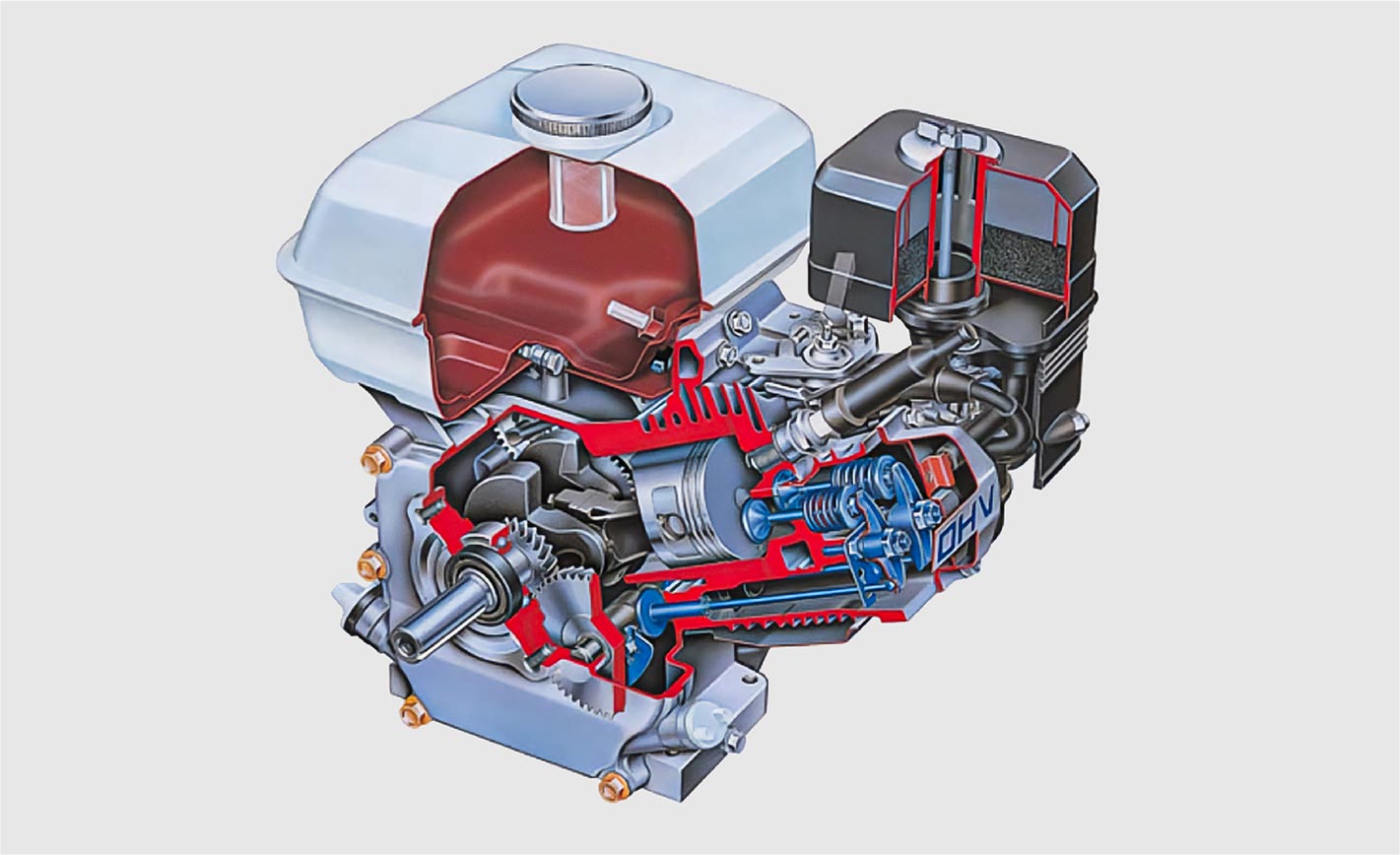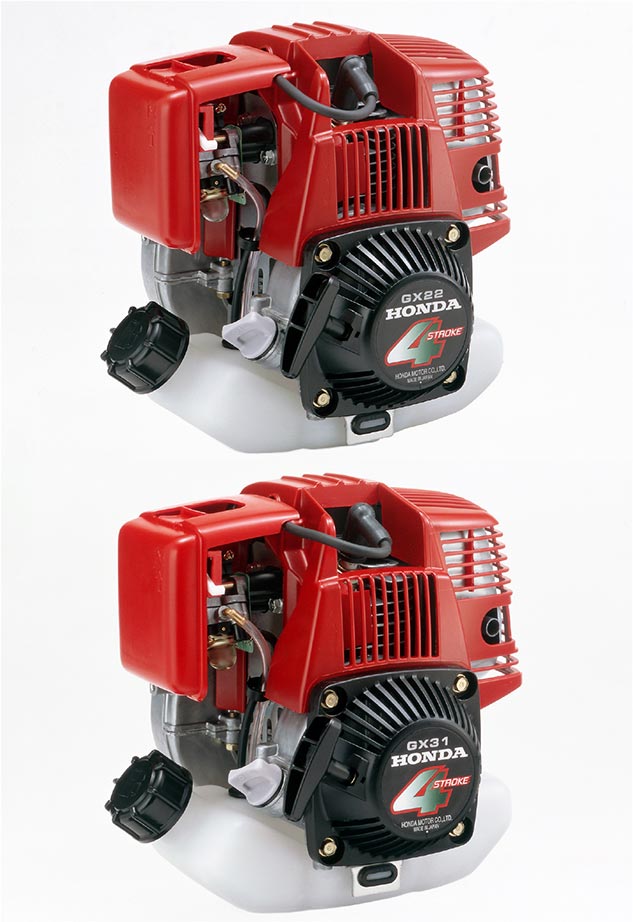The Engine OEMs Choose
The ME engine series, launched in 1977, was highly regarded for its superior starting performance, durability, and cost performance, and became a hit, reaching the target of 1 million units in 1982. Some dealers did not display ME engines in their stores because they “sold well even without showing them,” and some manufacturers even changed the color schemes of their products to red and white because of the many requests for red and white engines. However, not all went well.
As a result of the efforts by Honda’s developers in realizing the goal of halving the cost, the ME engine achieved a remarkably low price compared to competitors’ engines in the same class. Since price was the most important factor for general-purpose engines, the consensus was that this price difference was advantageous for Honda. However, in Japan, the results were not as good as expected. Honda’s developers visited the OEM manufacturers to promote the ME engine. However, the answers they received were often harsh.
For many power products makers, most OEM engines, manufactured for sale under other companies’ brand names, were supplied from engine manufacturers. Engines supplied by OEMs were not changed unless there was a major problem, partly because the time and cost to evaluate the performance of a new engine when it is installed in the machines they are to be used with. This meant that newcomers into an exisiting market faced difficulties unless they could produce innovative technology. The ME engine was undoubtedly a big success. With the introduction of the ME engine, Honda was able to gain enough strength to compete with other established manufacturers. That was why OEMs were willing to listen to Honda, even if they had harsh comments. There had to be, however, a more decisive difference to beat the competition, and convince OEM makers that they needed Honda engines. Honda engineers understood that difference, not variation, was needed, which led to the development of an epoch-making engine.
To Make an Epoch-making Engine Aiming for 3 Million Units
In October 1980, Honda gave the order to develop an engine for consumer products as its second project, following the ME engine targeting commercial use. Honda realized the need to expand into the consumer space in order to increase its market reach, and launched the ZE project, named after “Zillion” (indeterminately large number). The goal was 3 million units per year.
Honda did not supply the ME engine to OEMs with competing products, such as tillers, generators, and lawnmowers. For ZE Engines, Honda changed its stance to supply OEM products even for competing complete products based on the belief that “Honda’s complete products that cannot beat the competition will be eliminated by natural selection” and “Honda's unique products will naturally find their way to the OEM market.” Honda had decided to enter the OEM market on a full-scale basis.
The development team analyzed the large volume of requests and complaints they received through the ME engine selling well, and aimed to develop an innovative engine that was smaller, lighter, more economical, and maintenance-free. With society moving towards energy efficiency, and in order to achieve a decisive edge over other manufacturers, Honda made the decision to use OHV (overhead valve) engines, which offered higher output and lower fuel consumption than SV (side valve) engines, while most general-purpose engines at the time were SV.
Compatibility, Non-Negotiable for an OEM Engine
The OHV engine was high-performance, higher output, lower fuel consumption, quieter operation, better environmental performance, durability, and reliability compared to the SV engine, and had a proven track record in motorcycles and automobiles. No other manufacturer in the world had adopted it as a general-purpose engine on scale at that time.
The first task of the ZE project was to address the biggest issue of size, because if the engine deviated from the mounting dimensions that had been standardized for SV engines, it would not be accepted by OEMs. Normally, a general-purpose engine has a fuel tank mounted on top of the engine, and while an SV engine can be mounted as is, an OHV engine has a cylinder head with a valve mechanism underneath the tank, which increases the height. As a result, the engine layout would result in a high center of gravity, which would increase vibration, and would also affect the handling of the engine when it is mounted on work equipment. Honda’s engineers considered relocating the tank, but this was abandoned due to the additional functionality required to feed the gasoline, which would increase cost. The conclusion that was reached as a way to meet the requirements without incurring costs was the idea of tilting the cylinders, which are normally upright.
The idea of an inclined cylinder was not easily accepted, as the G25 released in 1966 had a near-horizontal inclined cylinder, and the development of this cylinder had been a battle with thermal and other problems. After repeated discussions, the conclusion was that the inclined cylinder was the only way to satisfy the installation compatibility requirements. The next question was, how many degrees did the cylinder need to be tilted? After interviewing farmers in mountainous areas who actually used tillers and conveyors on sloped terrain, and examining a range of 10 to 45 degree slopes, Honda engineers came to the conclusion that 25 degrees was the limit that would prevent oil buildup.
The weight and cost problems caused by the increased number of parts resulting from the conversion to OHVs, were solved by consolidating parts and other measures. The number of parts that would normally increase by approximately 20% was ultimately reduced to less than that of an SV engine. Furthermore, to make the engine easier to use, mechanical decompression and pointless transistor magnet ignition were adopted to improve starting performance.

Inclined cylinder OHV engine
Tilt angle determined by actually visiting farmers in mountainous areas and conducting tests.
OHV+Inclined Cylinders Become Industry Standard
In January 1983, the 3.5 hp GX110 and 5 hp GX140, developed through the ZE project, were launched. The GX110 and GX140 featured a number of new mechanisms, and were more economical, lighter, and easier to use. The introduction of the general-purpose OHV engine was welcomed by OEMs and took competitors worldwide by surprise.
In addition to high performance and low fuel consumption due to the OHV design, the engine also had the added advantages of a low center of gravity and low vibration due to the lower overall height achieved by the inclined cylinders. Furthermore, the ZE engine was actively matched to the specifications of each OEM manufacturer, and sales of the ZE engine steadily increased upon its launch, making it a core product that supported Honda’s power products operations. The ZE engine arguably revolutionized the general-purpose engine.
Because Honda had pursued what the general-purpose engine should be like, in order to realize the “Joy of Buying” by the customer, it was able to take on the challenge of developing the OHV engine, which no other manufacturer had attempted. Its ethos of developing products “for customers worldwide” had realized the innovative OHV engine.

Honda challenge to realize OHV engines “for customers worldwide” realized the GX110 and GX140, highly acclaimed as general-purpose engines.
One in Every Home, Engines for More Customers
Since the launch of the GX110 and GX140 in 1983, the GX series steadily increased sales volume while expanding its lineup, and by the mid-1990s, Honda’s general-purpose engine production was approaching 3 million units per year. In order to attract more customers to use Honda products, there was growing momentum within the company to make a further leap forward in the consumer space in addition to the booming commercial segment.
In the consumer space, which accounted for the overwhelming majority of the market, demand for handheld work equipment such as trimmers, chain saws, blowers, and sprayers, which are widely used around the world, was large, with 10 million units being sold worldwide per year. For the engines installed in these handheld work equipment, it was important to reduce engine size and weight. For this reason, two-stroke engines, which are compact and lightweight, were mainstream.
On the other hand, 2-stroke engines had been in need of improvement due to issues such as poor combustion efficiency, noise, vibration, and emissions accompanied by white smoke. In 1996, the California Air Resources Board (CARB) began enforcing the world’s first general-purpose engine emission regulations, and two-stroke engines required exhaust catalysts and other purification equipment.
Honda took this opportunity to start development of a 4-stroke engine for handheld work equipment with the hope of “contributing to people, the earth, and the future with the 4-stroke technology Honda cultivated since the T-Type engine in 1954.”
Said to be Impossible
The 4-Stroke Engine for Hand-held Equipment
Even today, 2-stroke engines are the most common for handheld work equipment because of their simple structure, small number of parts, and compact size and light weight. This is due to the lubrication structure of the 2-stroke engine, which can be operated in any posture and uses a unique gasoline mixture, meeting the requirements of handheld work equipment. 2-stroke engines are lubricated by a mixture of gasoline and engine oil, so they do not cause problems such as seizure even when the engine is tilted hard. On the other hand, 4-stroke engines are lubricated with engine oil stored in the crankcase, so operation at an inclination of more than about 30 degrees will interfere with lubrication and cause seizure and other failures. In addition, the structure is complicated due to the dynamic valve system, and from the viewpoint of weight and size, 4-stroke engines were said to be unsuitable for hand-held work equipment.
Development of a lubrication system that would allow 360-degree tilt operation was extremely difficult. Although some engine manufacturers had commercialized 4-stroke engines, they were not welcomed by the market as engines for handheld work equipment because of the tilt restrictions on operating conditions. Honda would not compromise, and through trial and error, built prototype after prototype, with the goal of achieving the same performance as a 2-stroke engine.
 Handheld work equipment that must be able to operate in any position and be compact and lightweight.
Handheld work equipment that must be able to operate in any position and be compact and lightweight.
The flexible ideas of the young engineers led to a breakthrough. First, a dry sump lubrication system with an independent oil tank chamber, which is also used in racing cars, was adopted to prevent oil from flowing into the combustion chamber regardless of the engine’s inclination. On top of this, a new technology, rotary slinger pumping lubrication system, was developed to lubricate the engine with atomized oil using a mechanism to prepare the oil. The key point was to use oil droplets rather than liquid.
The weight issue had been overcome by reducing the size and weight of the valve train components with the use of a resin cam and eliminating the use of steel sleeves by using high-silicon aluminum material for the cylinder. With a dry weight of 3.3 kg*2, the engine is as compact and light as a 2-stroke engine.
In addition, the engine met CARB and U.S. Environmental Protection Agency (EPA) emission regulations with a comfortable margin without the use of after-treatment devices, and achieved outstandingly low fuel consumption, proving the high environmental performance of the Honda engine.
- GX22 weight. GX31 was 3.4 kg
Strong Belief Led to Miracle
The GX22 and GX31, the world's first*3 ultra-compact, lightweight 4-stroke engines with a 360-degree freedom of tilting, released in March 1997, were installed in Honda hand-held work equipment such as trimmers and sprayers, and were also supplied to many work equipment manufacturers for their hand-held products on an OEM basis, resulting in cumulative sales of over 1.2 million units. In May 1997, these engines were awarded the EUROMOTENGINE IN AWARD 1997, which had never been given to a non-European manufacturer.
At an evaluation meeting held during the development process, some associates asked why they were developing 4-strokes if the customers wanted 2-stroke engines. The lubrication system was another factor that nearly pushed the development team into giving up. They stuck to their guns, however, replying that Honda was a 4-stroke company, and they had to produce “real hand-held engines.” It was this strong belief that led to commercialization, and high acclaim.
- Honda research (1997)

GX31 cut model - The rotary slinger pumping lubrication system, which atomized engine oil and is not affected by engine inclination, was developed, realizing continuous operation and storage at any angle.

GX22 and GX31 4-stroke engines with 360-degree free tilt
Strong belief in 4-stroke engines led to commercialization.
Toward a Carbon Neutral Society
Entering the 21st century, the need to address global warming and energy issues increased. In the 2020s, companies are stepping up their efforts to become carbon neutral, and the electrification of automobiles and motorcycles is accelerating. Honda, the world’s largest power unit manufacturer with annual sales of approximately 30 million units, is also working to lead the way in the electrification of its power products.
While the electrification of low output products such as brush cutters and light duty walk-behind lawnmowers has already progressed, the electrification of 2kW class power units used for heavy-duty machinery such as construction equipment has barely started, as there are no power units reliable and durable enough to withstand the intense vibration of road graders, plate compactors, and other construction machinery.
For Honda, the 2kW class is the GX series, its mainstay product which has been popular all over the world since its introduction in 1983. Honda took up the challenge of developing a general-purpose electric power unit ,by leveraging reliability technology cultivated with the GX engine. The eGX zero-emission power unit is designed to be as durable as the GX engine, with many measures taken to improve the rigidity and cooling performance of the motor’s internal structure, vibration isolation of the battery and control system, among other aspects. OEM supply of the eGX began in June 2021. In addition to being a major step toward carbon neutrality, the eGX is also expected to create a new market by meeting the needs of the construction machinery market, such as nighttime construction work in mines and areas near residences, which are difficult with engines.
Honda’s general-purpose engines are supplied to approximately 2,200 companies around the world on an OEM basis under the “Powered by Honda” brand. Honda continues to provide products that are as easy to use and as high performance as possible, while constantly introducing new technologies and ideas, and continuing Honda's founding desire to “make people’s lives better through technology.”

The eGX, a zero-emission general-purpose electric power unit, developed for a carbon-neutral society.








